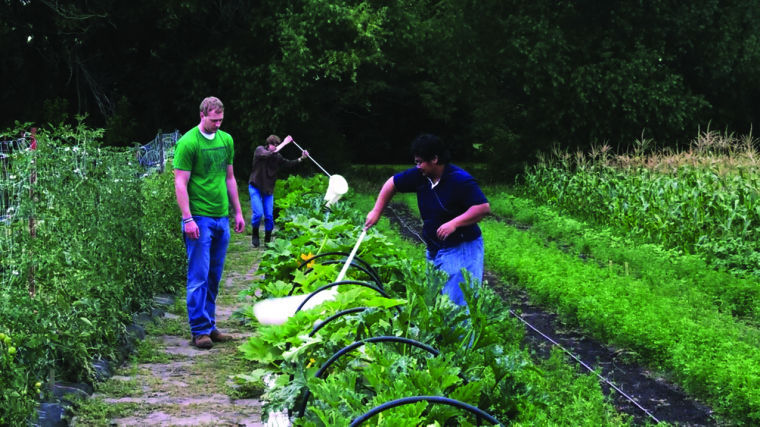Putting down roots
The SDSU Student Farm offers a unique hands-on experience for students and community memebers to learn about growing local foods. Through courses at SDSU studenst are able to learn and develop new techniques incluidng efficiency of irrigation systems and organic bug and weed control.
September 18, 2013
Go green, grow local. The SDSU Student Farm started in the spring of 2013 to be an educational project about local food production and introduce the idea of local food. The SDSU Student Farm is located on the Highway 14 Bypass just east of I-29.
There are a variety of vegetables grown at the farm including tomatoes, corn, peppers, cucumbers, summer and winter squash, green beans, peas cabbage, broccoli, herbs and perennial fruit crops such as raspberries and strawberries as well as apple and cherry trees, sunflowers and pumpkins.
“Right now we have less than one-third of an acre but will be expanding,” Kim James, plant science instructor and farm coordinator said.
The farm was a collaboration of the College of Agriculture and the Plant Science Department.
The crops grown at the farm are sold through a community supported agriculture share, which is where share members pay at the beginning of the season and each week receive a share of the crops harvested that week. The crops are distributed weekly at the Brookings Farmers Market.
Over the summer, James and two student workers helped with the planting and harvesting, one student, Brett Owens, helped all summer.
Brett Owens, a senior horticulture major has helped out with the Student Farm since the beginning. “I came back to SDSU to receive a degree in horticulture and had the good fortune of being right there at the beginning of the project,” Owens said.
The students at the farm also work on developing new techniques to help with efficiency of watering, such as drip irrigation and weed control.
All the processes used to grow crops are sustainable and organic, according to James. The weeds that are in the garden now will be tilled back in and put back in to the soil.
“Teaching people to grow their own food it is a great opportunity to get into local goods and show that a small farm can feed a lot of people,” James said.
James, plant science instructor, is in charge of the student farm and also teaching Horticulture 492, local food production. Students in the class go to the farm and are able to talk about what they are doing in class and actually get hands on experience as to why.
“The course is designed to learn about harvest and post harvest,” James said.
The class is offered in both the fall and spring. In the fall the students grow, harvest and also work on storing and preparing the garden for winter as well as the marketing aspect. In the spring, students will learn how to plan and prepare a farm for crops, and weather permitting, will begin to plant transplant plants and begin to plant the farm.
The crops are watered using an irrigation tank, which uses gravity for the pressure to transport the water. The farm is also gated off so there are no deer that get at the crops, and the farm also doesn’t have a rabbit problem, according to James.
“We are very excited, and we have support all the way through campus,” James said.
The SDSU Student Farm stopped at the market and asked to be a vendor, and started as a CSA drop off location at the market in July, according to Susan Gilkerson, Market Manager of the Brookings Farmers Market.
A CSA is a buying co-op and the customer pays the vendor and in return they get produce that is harvested from the farm every week. With a CSA, customers get a variety of fruits and vegetables – some they are used to and some they are not, which people like because it forces them to have produce they normally wouldn’t buy.
According to James, it was a real challenge to know how many shareholders the farm could take on, since it is the first year but the farm supplied crops to about 20 families. Next year the farm would like to have 40-50 shares which is almost double from this year. The farm hopes to grow but each year the growth will be fairly small, due to the size of the farm and also weather conditions.
“Since space is limited at the farm, we have to grow size-wise responsibly but we are going to continue with the share program,” James said.
The farm also donates crops as a service to the community such as shelters or food pantry.
Owens worked to harvest the crops and brought the shares to market on Wednesdays each week.
The Student Farm has one or two members at the market every Wednesday for people to pick up their produce from. They also have a chalkboard sign telling customers how much of each item they can take. It is set up as market-style, so the shareholders can pick out which fruits and vegetables they want, within the limits set up by the amount of produce available.
Gilkerson said that the members of the farm also serve as an information booth for locals who have questions on growing their own crops.
According to Gilkerson, the SDSU Student Farm has been openly received by the community.
“It is a good thing,” Gilkerson said.
The SDSU Student Farm Facebook page is the best way to find out about volunteer opportunities for anyone to get involved with the farm.
“It is great that South Dakota State is looking at the future of local food,” Owens said.
























